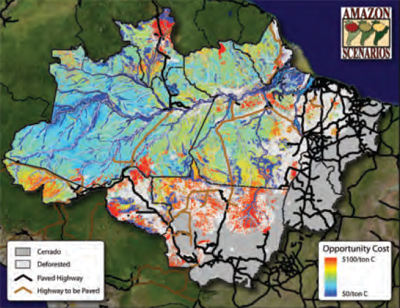How much would it cost to end Amazon deforestation?
How much would it cost to end Amazon deforestation?
mongabay.com
January 27, 2008
|
|
With Brazil last week announcing a significant jump in Amazon deforestation during the second half of 2007, the question emerges, how much would it cost to end the destruction of Earth’s largest rainforest?
According to estimates by the Woods Hole Research Institute (WHRC), reducing deforestation in the Brazilian Amazon to nearly zero within a decade would cost $100 million to $600 million per year under a program involving carbon credits for forest conservation (REDD). These figures are lower than the opportunity cost of foregone profits from deforestation-dependent agriculture and ranching and Brazil would see many benefits including:
-
increased income and improvements in livelihoods of indigenous and traditional forest people, greater security for the rainfall system of the Brazilian grain belt and hydroelectric network, and $10 to 80 million per year of diminished fire-related damages to health, agriculture, and forestry.
In short, avoided deforestation could offer the most cost-effective way to end deforestation while at the same time helping fight global warming.
Carbon emissions in Brazil
 Net opportunity cost of forest protection in the Brazilian Amazon. Calculated as maximum net present value of soy or cattle production minus NPV of timber. The value was then divided by forest carbon stocks. Red represents high opportunity costs for foregoing land-use activities. |
While 40% of total energy consumption in Brazil comes from renewable sources, the country is ranked as the world’s fourth largest emitter of greenhouse gases due largely to deforestation and forest degradation, which account for 70% of its total greenhouse gas emissions. These emissions primarily result from forest convesion for agricultural expansion — notably beef and soy production — in the Amazon. Despite this apparent link between between economic opportunity and deforestation, the WHRC report shows how forest clearing can be cost-effectively reduced by 95 percent within a decade.
REDD
WHRC’s analysis is dependent on REDD, a carbon credit regime that won preliminary approval at the U.N. climate talks in Bali this past December. REDD, which stands for reductions of greenhouse gas emissions from tropical deforestation and forest degradation, offers a mechanism for compensating tropical countries for reducing deforestation rates — and associated carbon emissions — below an established historical baseline. In other words, countries are effectively awarded carbon credits for protecting their forests. These credits can be sold as certified offsets global markets.
Factoring in REDD, WHRC pegs the average opportunity cost of forest protection for 94 percent of Brazilian Amazon forest at US$3 per ton of carbon, suggesting that over the first 30 years of the program, deforestation in the Amazon would be reduced by 490,000 square kilometers and approximately 6 billion tons of carbon emissions would be avoided at a cost of $8 billion. The program would double the income of 200,000 forest-dwelling families as well as impoving health and education in the region. Private landownders would also see compensation for preserving forest cover on their land.
“The report is designed to quantify what it would cost to compensate fairly those stakeholders who have a fair and just claim for compensation in moving toward zero deforestation,” Dr Daniel Nepstad, a senior scientist at WHRC and lead author of the study, told mongabay.com. “carbon credits through REDD will provide a major economic incentive to leave forests standing. ”
Daniel C. Nepstad, et al (2007). “Brazil: The costs and benefits of reducing carbon emissions from the Brazilian Amazon region” in Final Report to The William and Flora Hewlett Foundation From The Woods Hole Research Center: Linking Climate Policy with Development Strategy in Brazil, China, and India. November 15, 2007